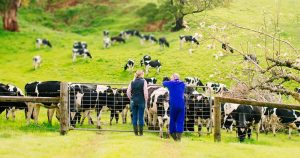Understanding Protein
Proteins are involved in every aspect of a cows’ life. They contribute to muscle development and movement, the immune system, growing calves, the reproductive system, are building blocks for hooves, horns, skin, fur, bones, teeth and of course milk.
What we need to know about proteins is that the cow needs to eat a kilogram of protein per day just to stay alive. If she is pregnant, add about 200 grams per day to grow a calf. The cow allocates feed eaten in this order, first maintenance, second pregnancy, thirdly weight gain (if she is skinny) and finally milk production. After these demands have been met, it takes approximately 80-100 grams of dietary protein to make a litre, depending on milk solids percentage and stage of lactation.
This means that if you are targeting 30 litres of milk per cow per day then you need to feed her one-kilogram of protein to stay alive, 200 grams to feed a calf, plus 2.5-3.0 kilograms of protein to produce the milk. That gives a total of 3.5-4.0 kilograms of protein required to produce 30 litres of milk. If that cow was eating 5 kilograms of 12.0% crushed grain/pellets in the dairy plus 15.0 kg of 30.0% pasture in September that would be easy. She would receive 600 grams dietary protein in the dairy plus 4.5 kilos in the paddock so there would actually be excessive dietary protein.
In November, we see a problem arise. At some stage, the pasture will drop to as little as 10-15 % dietary protein as the grasses go to seed. This means that 15 kilograms of grass only provides 1.5-2.0 kg of protein to go with the 600 grams being eaten in the dairy. The target for 30 litres of milk remains at 3.5 to 4.0 kilograms dietary protein per day.
The cow still needs a kilo a day to stay alive and the calf does not want to stop growing so the only area that the cow can sacrifice is milk production. This happens on every dryland farm every year and it is common to see milk production crash by 25-30%. Farmers should not accept this loss as inevitable.
We cannot change how our pastures respond to hot dry summers, but we can change the grain in the silo. If you lifted the protein percentage in the silo from 12 to 20%, you would give the cows an extra 400 grams of protein in a 5 kilo per day ration. That is mathematically enough protein to save 4.0-5.0 litres of milk when the pastures go off. That 4.0-5.0 litres, is lost income to the tune of $2.00 to $2.50 dependent on several factors. The cost of increasing the protein in your grain/pellet would be about 30 cents / day compared to a low protein ration.
Talk to your Reid Stockfeeds representative about this. You have nothing to lose but everything to gain.
